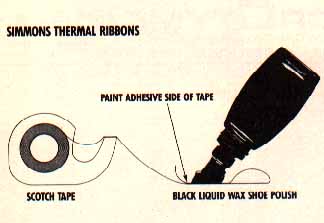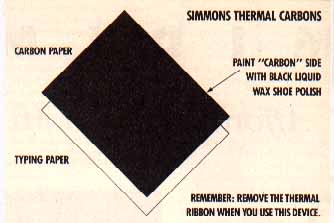SIMMONS THERMAL RIBBONS
Ink your own - get better copies
By Thomas Simmons
It's hard to resist those low prices on thermal printers. However, there are two drawbacks to these apparent bargains. Ribbons are expensive, one-shot items and the printed copy is generally of low quality, usually too light.
Now I have come up with a way to ink your own ribbons--and get better copies.

SIMMONS THERMAL RIBBONS
Prices for thermal ribbons can range as high as six dollars each. Do you want to pay fifty cents per page of printout? Of course not. So why not do-it-yourself and make Simmons' Thermal Tapes? For about thirty-three cents you can make yourself 200 yards of thermal tape. Here is what you need:
Scotch Tape in 200 yard rolls, 1/12 inch width.
Black Liquid shoe polish.
Unwind the Scotch tape on a sheet of newspaper, spreading the liquid shoe polish on the sticky side of the tape. Let the tape dry thoroughly. When you have coated all the tape, rewind it into a roll.
Properly coated, the tape will no longer be sticky. The liquid shoe polish is a wax that clings to the sticky part of the tape. When you wind this tape on the spools of your thermal printer, be sure that the waxy side faces the paper on which you will print. Otherwise, the printhead will clog with wax and nothing will print. (Antic holds no responsibility for any damages resulting from use of the techniques described in this article.-ANTIC ED)
When you print, the thermal pins of the dot-matrix momentarily heat the smooth side of the tape. This heat melts the black wax of the shoe polish, which immediately transfers to the typing paper. The result is permanent and waterproof, producing a high quality, non-smear printout! Try it, and you'll quickly be convinced that my Simmons Thermal Tape idea is pure genius, or pure Shinola, depending on the type of shoe polish you use.
This process will also work on your old Atari 825 dot-matrix printer. Just put the liquid shoe polish on your printer ribbon and start printing. The waxy polish actually preserves the ribbon and there is no drying out. Cost: about three cents per ribbon reinking! A caution, however: there will be a wax buildup on your printhead that needs periodic cleaning.
If you have a craving for color, you might try taking a wax crayon to your adhesive tape. Mark the sticky side of the tape with any color of crayon. Be careful to cover the tape thoroughly with the crayon. Then wind the tape onto your printer spools. As before, make sure you print with the sticky side toward the paper you're printing on.

SIMMONS THERMAL CARBONS
You can also make your own thermal carbons. Go out and buy the cheapest carbon paper you can find. It is generally low quality stuff, made of thin, almost plastic, paper. This works to your advantage when it comes to heat-transfer printing.
Take that bottle of black liquid shoe polish and evenly paint the carbon side of the paper. Let it dry.
Put the dry carbon paper on top of a clean sheet of typing paper, painted side down. Take the old thermal tape out of the printer and insert the paper with the back of the carbon paper facing the printhead. The thermal dot-matrix pins strike the carbon paper and transfer a brilliant black wax image to your typing paper.
Depending on the price of your typing paper, the cost should be about two cents per page. This goes down to a fraction of a cent per page of print, if you re-coat the same carbons. How's that for home-grown savings?
NOTE: Don't use this technique with the Atari 1027 printer. You really must have the proper ink rollers to get the high quality results this printer is capable of.
Not only does black liquid shoe polish work well on home-made ribbons for thermal printers and the Atari 825, it is also excellent for touching up grey streaks in your hair. If you're bald like me, all you can do is put it on your shoes and use it with your printers.
Thomas Simmons areas of expertise include CAT scan technology, nuclear magnetic monitoring, medical sensor construction, and creating handy do-it- yourself projects for the Atari. His quirky, but practical, tips have previously appeared in the May and June 1987 issues of Antic.